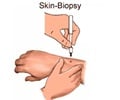While candy, flowers and dinner at a romantic restaurant may seem like great Valentine’s Day gifts, the American Academy of Dermatology (Academy) recommends that people give the gift of life and health this year and “Screen the One You Love” for skin cancer.
Based on current estimates, more than 1 million new cases of skin cancer will be diagnosed in the United States in 2009. Performing regular skin self-examinations is an easy way to detect suspicious moles that could be cancerous, and research shows that involving a partner in the self-examination process can improve the early detection of skin cancer.In a study published in the Journal of the American Academy of Dermatology, dermatologists found that people who are assisted by a partner in performing skin self-exams are more likely to follow a regular detection routine than those who rely solely on themselves for motivation.
“Since skin cancer is the only cancer you can see on the surface of your skin, it makes sense to ask a partner who regularly sees your skin to assist you in performing a skin exam,” said dermatologist C. William Hanke, MD, MPH, FAAD, president of the Academy. “A partner can help you assess whether a mole seems to be changing or shows any signs that could raise a red flag, and Valentine’s Day is the perfect time for people to start a new tradition by giving each other the gift of a skin examination.”
The Academy’s Body Mole Map is a tool individuals can use to track their moles. The map provides information on how to perform a skin exam, images of the ABCDEs of melanoma and space for people to track their moles to determine any changes over time. The mole map is available at www.melanomamonday.org.
“In my practice, oftentimes patients tell me that their partner urged them to get an unusual-looking mole checked – and in some cases these moles turn out to be skin cancer,” added Dr. Hanke. “Early detection is crucial in the fight against skin cancer, so a partner can be a tremendous ally by helping you examine hard-to-reach spots and encouraging you to see a dermatologist if you notice an unusual lesion or mole.”
One American dies of melanoma almost every hour (every 62 minutes). The five-year survival rate for people whose melanoma is detected and treated before it spreads to the lymph nodes is 99 percent. For more information about skin cancer, please visit the SkinCancerNet section of www.skincarephysicians.com, a Web site developed by dermatologists that provides patients with up-to-date information on the treatment and management of disorders of the skin, hair and nails.
Advertisement
SRM














